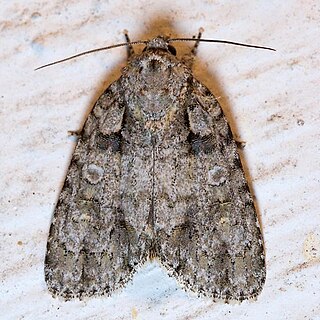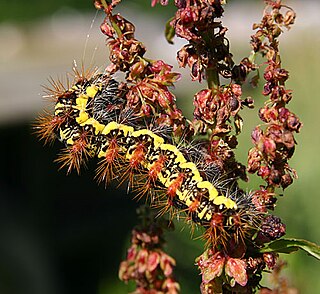
The miller is a moth of the family Noctuidae. It is found throughout Europe apart from the far south-east. The range extends from the South of Spain, Central Italy and Bulgaria to Scotland and Central Scandinavia, crossing the Arctic circle in Finland and Norway. Outside Europe it is only known in North Africa. In the Eastern Palearctic and the Nearctic realm it is replaced by Acronicta vulpina, formerly known as Acronicta leporina subspecies vulpina.

Acronicta is a genus of noctuid moths containing about 150 species distributed mainly in the temperate Holarctic, with some in adjacent subtropical regions. The genus was erected by Carl Linnaeus in his 1758 10th edition of Systema Naturae. Caterpillars of most Acronicta species are unmistakable, with brightly colored hairy spikes, and often feed quite visibly on common foliate trees. The hairy spikes may contain poison, which cause itchy, painful, swollen rash in humans on contact. The larva of the smeared dagger moth is unusually hairy even for this genus. Acronicta species are generally known as dagger moths, as most have one or more black dagger-shaped markings on their forewing uppersides. But some species have a conspicuous dark ring marking instead.

Acronicta increta, the raspberry bud dagger moth, raspberry bud moth or peach sword stripe night moth, is a moth of the family Noctuidae. The species was first described by Herbert Knowles Morrison in 1875. It is distributed throughout the south of Canada and the United States down to Florida and Texas.

Acronicta lanceolaria, the lanceolate dagger moth or pointed dagger, is a moth of the family Noctuidae. The species was first described by Augustus Radcliffe Grote in 1875. It is found in North America, from Nova Scotia to British Columbia. It is listed as a species of special concern and believed extirpated in the US state of Connecticut.

Acronicta lobeliae, the lobelia dagger moth or greater oak dagger moth, is a moth of the family Noctuidae. The species was first described by Achille Guenée in 1852. It is found in North America.

Acronicta oblinita, the smeared dagger moth or arioch dagger, is a moth of the family Noctuidae. Its larva, the smartweed caterpillar, has urticating hairs. The species was first described by James Edward Smith in 1797.

Acronicta tritona, the Triton dagger moth, is a moth of the family Noctuidae. The species was first described by Jacob Hübner in 1818. It is found in eastern North America, from Nova Scotia west to north-eastern Alberta, south to Florida and Texas, and west to Oregon.

Acronicta lepusculina, commonly known as the cottonwood dagger moth, is a species of moth in the family Noctuidae. The species was first described by Achille Guenée in 1852. It is found in most of eastern North America, west through southern Canada to Vancouver Island and southward.

Acronicta sperata, the hopeful dagger moth, is a moth of the family Noctuidae. The species was first described by Augustus Radcliffe Grote in 1873. It is found in North America from New Brunswick west to the Alberta foothills, south to the District of Columbia, Missouri and in the mountains to Colorado.

Acronicta impressa, the impressive dagger moth or willow dagger moth, is a moth of the family Noctuidae. The species was first described by Francis Walker in 1856. It is found from western Canada to north-western Mexico.

Acronicta interrupta, the interrupted dagger moth, is a moth of the family Noctuidae. The species was first described by Achille Guenée in 1852. It is found across southern Canada south of the boreal forest, from New Brunswick west to eastern Alberta, south to Georgia, Nebraska and Arizona.

Acronicta funeralis, the funerary dagger moth or paddle caterpillar, is a moth of the family Noctuidae. The species was first described by Augustus Radcliffe Grote and Coleman Townsend Robinson in 1866. It has a scattered distribution. It is found in North America from Manitoba to Nova Scotia, south to Maryland. It is also found in Georgia, Mississippi, Texas, and along the west-coast from California to British Columbia.

Acronicta hamamelis, the witch hazel dagger moth or puzzling dagger moth, is a moth of the family Noctuidae. The species was first described by Achille Guenée in 1852. It is found in Canada and parts of the United States, including Maryland.

Acronicta hastulifera, the frosted dagger moth, is a moth of the family Noctuidae. The species was first described by James Edward Smith in 1797. It is found in the north-eastern United States as far south as Virginia, North Carolina, South Carolina and Georgia.

Acronicta heitzmani, or Heitzman's dagger moth, is a moth of the family Noctuidae. The species was first described by Charles V. Covell and Eric H. Metzler in 1992. It is found in Missouri, Arkansas, Illinois and Ohio.

Acronicta laetifica, the pleasant dagger moth, is a species of moth in the family Noctuidae. The species was first described by John Bernhardt Smith in 1897. It is found in North America from Nova Scotia to Florida, west to Texas, north to Manitoba.

Acronicta inclara, the unclear dagger moth, is a moth of the family Noctuidae. The species was first described by John Bernhardt Smith in 1900. It is found in north-eastern North America.

Acronicta falcula, the corylus dagger moth, is a moth of the family Noctuidae. The species was first described by Augustus Radcliffe Grote in 1877. It is found in the United States and Canada from southern New England to southern Manitoba and Iowa. Recently seen from Wisconsin, Connecticut, Rhode Island, New York and Michigan. It is reported as rare in Ohio. It is listed as a species of special concern in the US state of Connecticut.

Acronicta lupini, the lupine dagger or little bear, is a moth of the family Noctuidae. The species was first described by Augustus Radcliffe Grote in 1873. It is found from Quebec, Newfoundland and Labrador, British Columbia, Alberta and Yukon in Canada, south to California.

Acronicta insita, the large gray dagger or fingered dagger, is a moth of the family Noctuidae. The species was first described by Augustus Radcliffe Grote in 1874. It is found from Newfoundland west to the Pacific coast and Vancouver Island and Haida Gwaii, British Columbia, south to North Carolina and Colorado.












